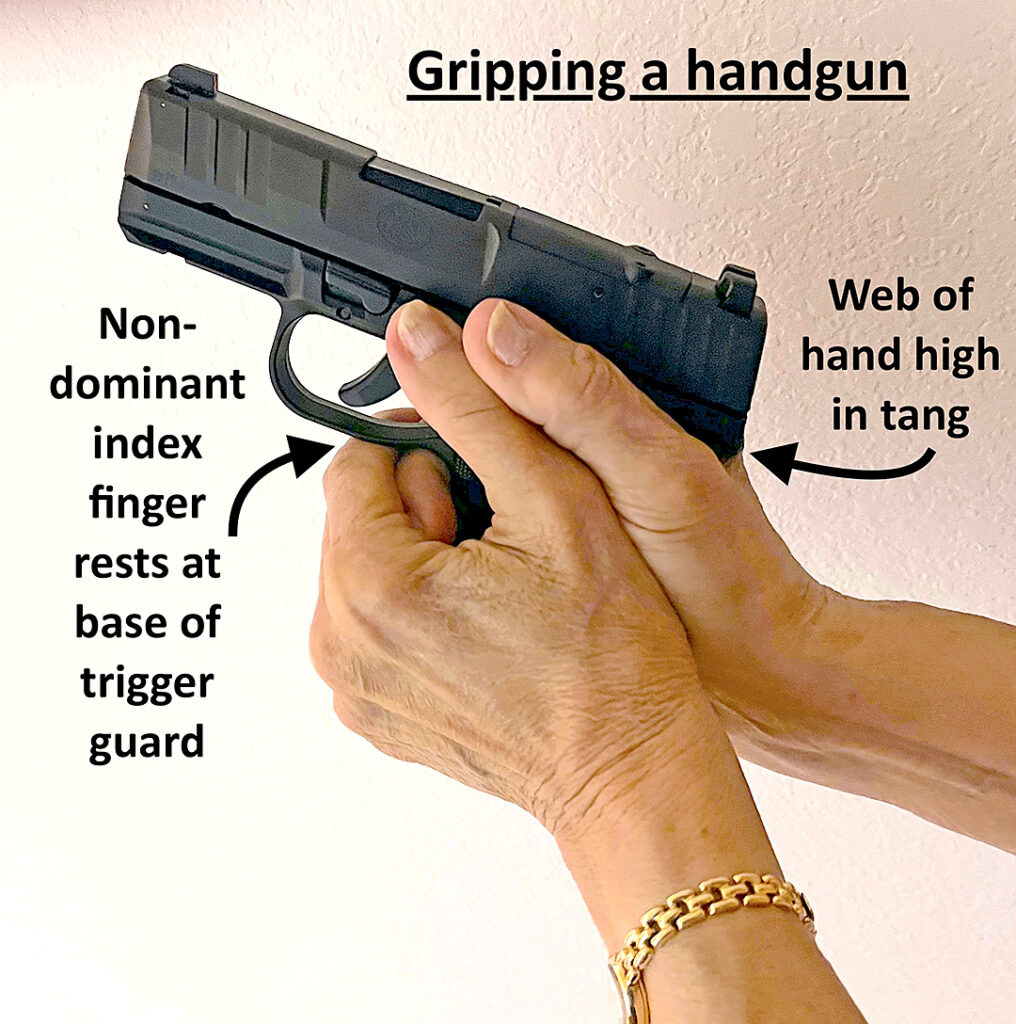Thoughts on a good grip, Part 2


Last week, we discussed a few thoughts on what makes a good grip. These fundamentals are based on an article I read on Guns & Ammo by Richard Nance. While reading, I’m thinking: “Yes, exactly! Couldn’t have said it better!” but also wondering “What does he mean by that?” So, after discussing each paragraph with Joe, I’m taking Nance’s article and writing it without long sentences and big words.
We started by describing how to keep our grip high, and to put the web of thumb and forefinger snugly into the tang or beavertail. We discussed bore line, aligning the gun with our forearm, and avoiding “limp-wristing.” Internalizing these ideas when shooting helps us to keep down the recoil and to shoot more accurately. Isn’t it easier to shoot without having the gun kick too much? Isn’t it more fun to whack holes in the center x-ring of our target?
Before, we were talking about things to remember with our dominant hand. But wait! There’s another hand! We want both hands on the grip!
Again, we want to minimize that dreaded recoil. How we use our non-dominant hand can make a difference too. One way we figure this out is to make sure the heels of our palms meet on the grip. Now that they are together, it’s time to cant that non-dominant hand forward so that our non-dominant thumb points towards the target. Remember, keep the heels together.
Is our dominant hand gripping high in the tang? Is our dominant forearm aligned with the gun?
With heels of hands together and thumbs pointing to the target, it’s time to lock both wrists firmly. How?
With heels of hands together, our dominant hand is going to be locked when we apply pressure to the front and back of the grip: sort of like squeezing pliers. Squeeze firmly. Now our dominant hand is locked.
Our non-dominant hand?
That guy is responsible for squeezing the grip side to side. The grip is now firmly squeezed front to back and side to side and our hands are completely surrounding the grip.
So, how hard do we squeeze to lock our grip?
Nance’s response is to grip somewhere between “Grip your pistol as if you were giving a firm handshake” and “Grip it as hard as you can.” Nance’s advice is to “Think of your grip as more than a firm handshake but less than a death grip.” If our grip is too firm, we’re likely to become tired and wobble. A wobbly grip isn’t going to do much for accuracy when shooting.
Since our hands are holding the grip firmly, what are our arms going to do?
Again, there is more than one school of thought here.
Nance discusses his early training in police shooting. “I was taught to extend my arms fully.” But now he thinks differently. So, try it. But again, first make sure your gun is empty.
Then, when pointing your gun in a safe direction and extending your arms fully, what will take the brunt of the recoil? Your shoulders do. As you shoot and as your shoulders are impacted by the recoil, your arms and the handgun will rise because your shoulders are acting like hinges. When your arms rise from the recoil, your gun is no longer pointed at the target. What good is that?
Instead, Nance cautions us to bend our elbows slightly. This allows the “forces of recoil to direct the gun more horizontally.” Now, we experience less muzzle rise.
There’s a sweet spot for each person somewhere between extending arms fully and bending them somewhat. It’s a spot we all have to discover for ourselves.
Now, as we raise our arms toward the target, our non-dominant hand should be about as high as our lower chest. Remembering to keep the heels of our hands together, we wrap the fingers of our off hand around our dominant hand. When we do this, the off hand’s index finger rests at the bottom of the trigger guard. That off hand finger’s second knuckle rests against the second knuckle of the dominant hand’s middle finger’s second knuckle.
As our arms extend, our off hand’s wrist cants forward as the grip tightens. We find out that if we cant our off hand wrist too far forward, we might lost contact of the heels of our hands. This is one way to know how far forward our arms should be. Keeping contact of the heels of our hands while extending our arms makes for the best recoil management.
Finally, our dominant hand’s thumb applies pressure to the base of the non dominant thumb. Then, when you extend your arms to fire, you can apply pressure all around the grip. Front to back and side to side; the grip will be firm and secure.
Nance sums up: “While there are bound to be nuances to one’s grip based on hand size, physicality and even personal preference, there’s a reason the best shooters in the world adhere to these basic concepts. They work. A proper grip results in faster and more accurate rounds on target. That’s the goal whether you’re competing for a title or competing for your life.”
Pick up your handgun. Check once more to make sure the gun is empty. Now, grip your gun and extend your arms.
Is your dominant hand high in the tang of your gun? Is your forearm aligned with the gun? Do the heels of your hands stay together as you extend your arms? Does your dominant thumb press firmly against your non dominant one? Are your wrists locked when you apply pressure front to back and side to side?
If you haven’t purchased a gun yet, first make sure the gun you want to “see” has no rounds in either the chamber or the magazine. Then grip the gun and extend your arms. If you can answer “yes” to the questions above, you are one step on the way to find a gun that fits your hands.
Marj Law is the former director of Keep Wakulla County Beautiful who has become an avid shooter in retirement.


